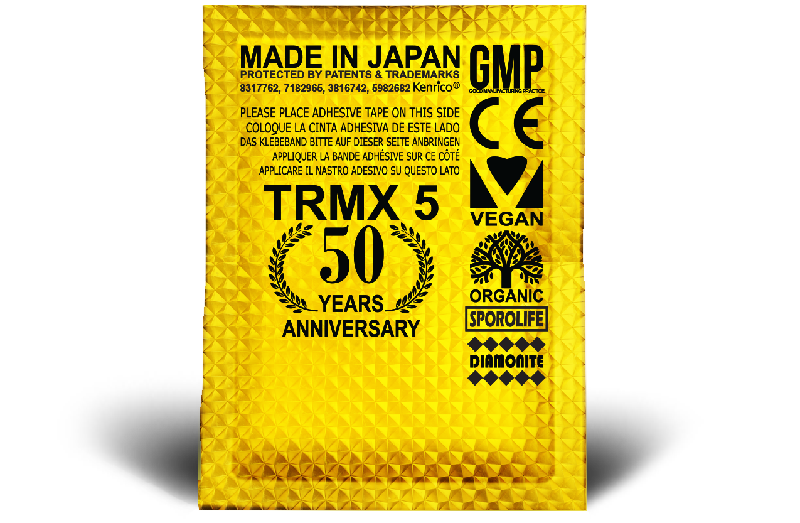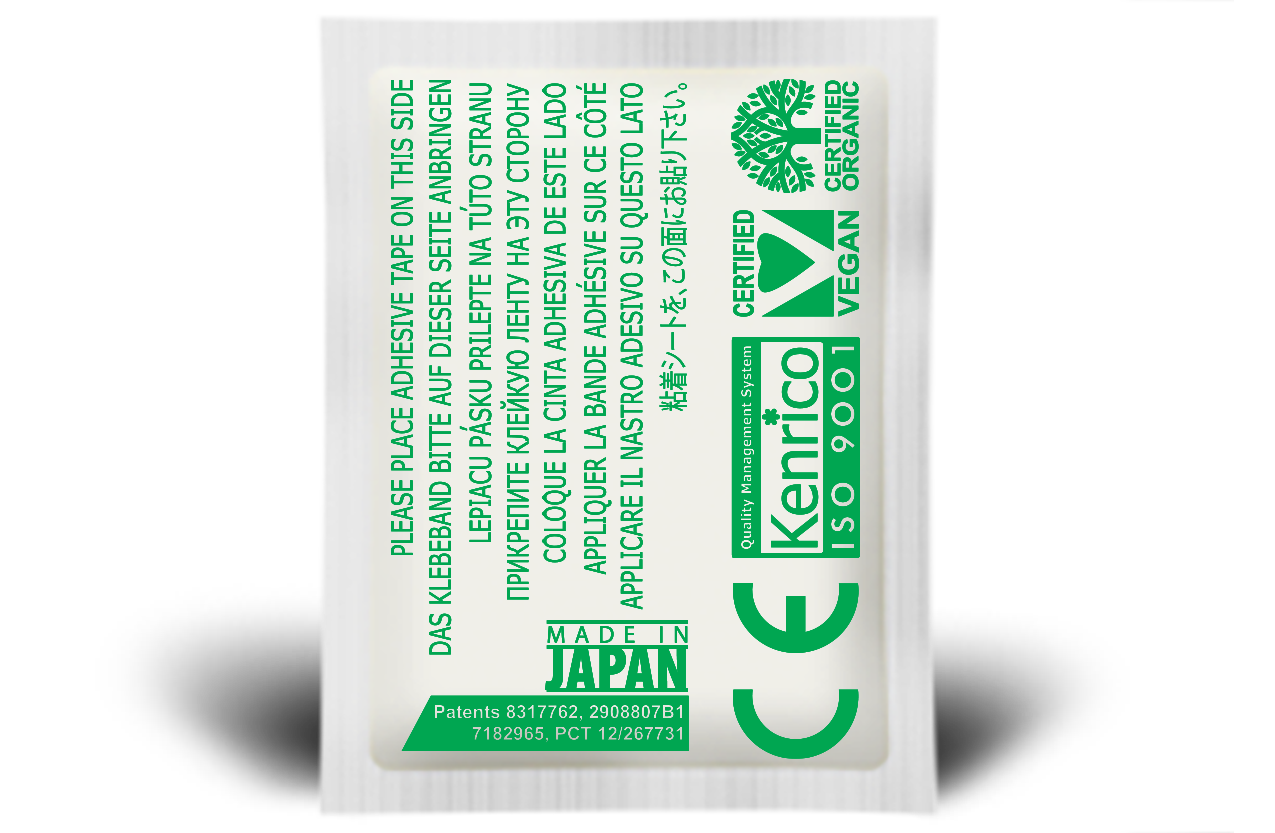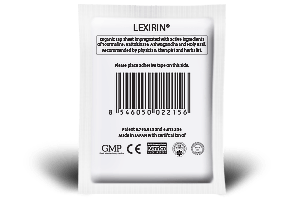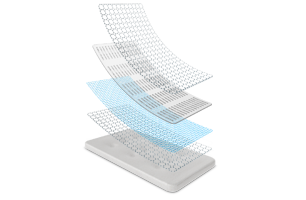Research & Peer Review Studies
LBA07: Lifestyle & Blood Analysis (October 25, 2006 - April 25, 2007)
Test article: Kenrico SAP Sheet
Blood testing (CRP, TP, ALB, GOT, GPT, Serum gamma-GTP, TC, TG, HDL, UA, BUN, CRE, GLU) is important for the detection of new diseases and identification of changes in existing disease status. Recent clinical studies demonstrate that Kenrico Detox Pads can significantly increase our bodies equilibrium, and assist in the treatment of conditions such as diabetes, liver and heart disease.
CRP (C-Reactive Protein)
CRP is a naturally occurring substance in the body when inflammation and/or infection is present. A simple blood test can detect the levels of CRP in the blood, and depending on the
result, it can suggest infections, bacterial and viral, and inflammation from autoimmune diseases. The normal level of CRP in the blood is around 10mg/L or less. In those people with an acute illness, it can be as
high as 100mg/L.
TP (Total Protein)
Liver disorders can be detected by assessing the protein levels in the body. If the result is low it is characteristic of liver disease or kidney problems. These are disorders caused by the
body's inability to efficiently digest protein. By testing the ratio of albumin to globulins the results can show a doctor the cause of the change in the body's protein levels. A result showing a low A/G result may
suggest an autoimmune disease, or it could suggest cirrhosis of some sort. Whereas, a high ratio of A/G can suggest low immunoglobulin's which can be characteristic of leukaemia. At that point, more in depth tests
would be carried out.
ALB (Albumin)
Low albumin levels are an indicator of liver disease. Further tests would then need to be carried out to show which type of disease is present in the liver. A result that shows a low level of
albumin in the body can be indicative of kidney problems. At that point, a simple test would be carried out to detect the protein levels present in the urine. Low levels of protein can suggest inflammation,
malnutrition or Chron's disease in the patient. Whereas high levels can suggest that the patient is seriously dehydrated.
GOT (AST)
If the level of AST reaches significant levels in the body then hepatitis is a possibility. If the hepatitis has reached acute status then the AST levels will remain high for up to several months
after detection and up to six months in some cases. If the disease has reached chronic levels the AST level is lower than at other stages of the illness. To follow the pattern of the disease regular tests are
necessary to track the progress of the infection.
GPT (ALT)
The ALT test is used to determine liver injuries. The results of the test (ALT) are normally compared with the results of other tests to show which type of damage or disease is present in the liver.
If the result show abnormally high levels of ALT this can suggest the patient is suffering from hepatitis. Acute hepatitis patient's results will show that the ALT levels remain high for several months. ALT levels
will vary dependant on the stage of the illness. Where the patient suffers from liver disease, the ALT levels may remain at normal levels.
Serum Gamma-GTP
People, who regularly fail to exercise, smoke excessively or who are seriously overweight, will present with oxidative stress. This induces plasma membrane-bound protein damage in hepatic
cells and elevates the serum gamma-GTP levels.
TC (Total Cholesterol)
High levels of cholesterol can lead to life threatening diseases and hear t problems that can result in death. Doctors will often conduct regular blood tests to monitor the levels of
cholesterol in the blood. This test is not carried out to diagnose illness, but to predict the possibility of the patient suffering from a serious illness in the future. Early detection is crucial to enable the
patient to change lifestyle to reduce the levels present in the blood.
TG (Triglyceride)
A test carries out to predict the likelihood of a patient developing heart disease. TG is a blood test, part of a lipid profile, which is used to calculate risk. Diabetic patients are
regularly monitored to ensure their levels remain constant ad a rise may indicate blood sugar problems. A normal level for fasting triglycerides is less than 150 mg/dL (1.70 mmol/L). Doctors will treat high LDL
cholesterol differently than cholesterol that presents with high triglycerides. However, should only the triglycerides be high, it can be indicative of pancreatitis and a treatment regime will be prescribed
immediately.
HDL
HDL is part of the cholesterol test and a high result is more desirable than a low one. Low HDL, less than 40 mg/dl, can be an indicator of an increased heart disease risk. A normal level, 60 mg/dl, is
the preferred result and shows a significantly decreased risk of developing any heart diseases. When the test is carried out it is normally reported as a 'measured value' by the laboratory. The measured value ratio
is obtained by dividing the total cholesterol by the HDL cholesterol. For example, if a person has total cholesterol of 200 mg/dL and an HDL cholesterol level of 50 mg/dL, the ratio would be stated as 4 (or 4:1).
The optimum result of a cholesterol test would be that of 3.5 or lower.
UA (Uric Acid)
Uric acid can be used to show doctors if the body is breaking down waste products and dead cells efficiently. In some people, the body doesn't break down the cells and eliminate them quickly
enough and eventually it can result in kidney stones forming. In diseases such as rheumatoid arthritis the uric acid crystals form on the joints causing severe pain. Also, following a course of chemotherapy, the
levels of uric acid will be regularly monitored to see if the uric acid levels have been raised, suggesting problems processing the purines.
BUN (Blood Urea Nitrogen)
High levels of BUN are indicative of kidney problems. This test is used to determine the kidney's ability to rid itself of urea, the waste proteins. In kidney failure the levels will
be significantly elevated. Other conditions that reduce the flow of blood to the kidneys, such as a heart attack, burns or dehydration can also cause an elevated result. Gastrointestinal bleeding can also give a
higher result due to the protein levels present in the blood. A low BUN result is normally nothing to worry about and is preferable to raised levels.
CRE (Creatinine)
Changes in CRE can indicate kidney problems. CRE is a protein in the blood that should remain at a constant level. If the CRE levels in the blood are higher than would normally be expected it
may indicate the possibility of a kidney affecting illness.
GLU (Glucose)
A test used to determine diabetes. It is used to detect both hyperglycemia and hypoglycemia and helps doctors to diagnose diabetes and should ideally be carried out at least twice to give a
broad picture of the blood levels. The test is normally carried out by pricking the finger and measuring the levels of glucose in the blood. The results will indicate whether medication and/or insulin need to be
administered. Diabetics have to monitor their own blood many times per day to maintain their blood sugar levels. Again this is done by pricking the finger onto a special glucose strip. The strip is then inserted
into a machine, called a glucose meter, to give the patient a digital readout of their levels. Depending on the result the patient will know how to administer their drugs.
Males and females, between 18 and 75 years of age, random BMI (20.0-39.9), were enrolled in the study. Potential subjects reported to the study site, vital signs were measured and recorded for a period of 6 months. A ten to twelve-hour fasting blood sample was drawn for measurement.
RESULT
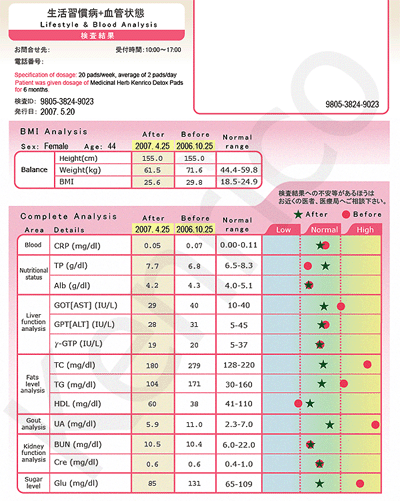
Blood analysis on a 44 year old female.
Noticeable improvement in both glucose and fat levels.
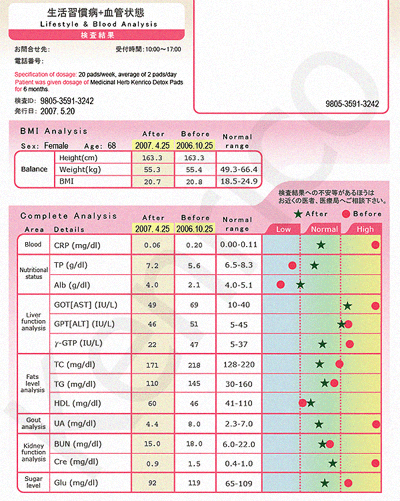
Blood analysis on a 68 year old female.
Significant improvement in liver and kidney function, and completely reduced the threat of developing diabetes, gout and infection.
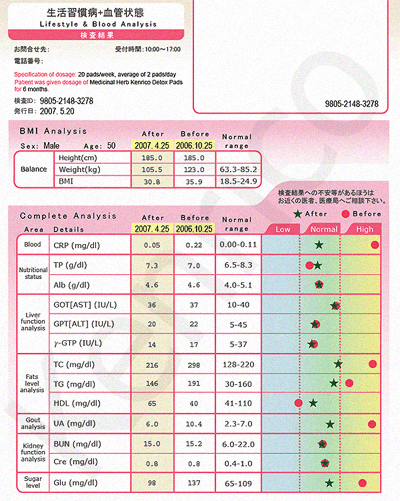
Blood analysis on 50 year old male.
Noticeable improvement in both glucose and fat levels. Removed gout and infection.
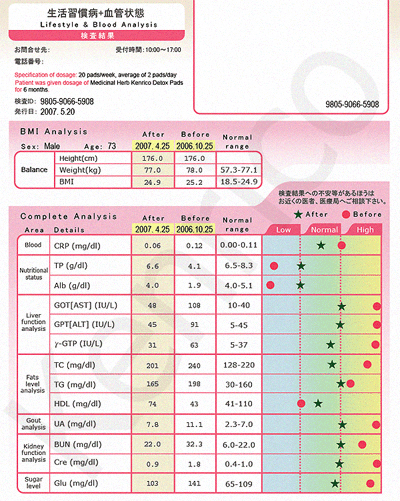
Blood analysis on a 73 year old male.
Significant reduction from the threat of Hepatitis and type-2 diabetes.
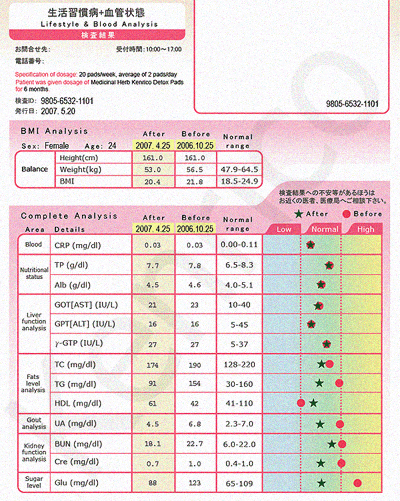
Blood analysis on a 24 year old female.
Significant improvement in kidney function. Full recovery from the threat of developing pre-diabetes and gout.


